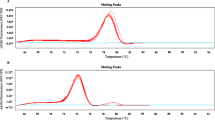Abstract
A rapid quantitative polymerase chain reaction (QPCR) method was developed for simultaneous detection of enteric bacteria from surface waters by utilizing a pair of universal primers which targeted four bacteria strains, namely Shigella dysenteriae, Vibrio cholerae, Salmonella typhimurium, and Escherichia coli. It was estimated that the QPCR method had a 94% confidence, and a detection limit as 2.7 E. coli cells per sample in undiluted DNA extracts. The QPCR method was applied for the bacteriological examination of several surface waters in the urban area of Xi’an, China and comparison was made with the conventional bacteria indicators determined by conventional membrane filter (MF) method. As a result, the calibrator cell equivalents (CCE) determined by QPCR was 2.2 to five times of the total coliform CFU, and the characteristics of the bacterial quality of different waters could be well presented by the QPCR results with a higher sensitivity. The coefficient of variation (CV) of data obtained by QPCR was smaller than that by traditional MF method, indicating a more stable analysis result. The QPCR method could thus be used as a supplement of the conventional culture method for more sensitive detection of pathogenic enteric bacteria from water.
Similar content being viewed by others
References
Alexandrino, M., Grohmann, E., & Szewzyk, U. (2004). Optimization of PCR-based methods for rapid detection of Campylobacter jejuni, Campylobacter coli and Yersinia enterocolitica serovar 0:3 in wastewater samples. Water Research, 38, 1340–1346. doi:10.1016/j.watres.2003.10.036.
Abu-Halaweh, M., Bates, J., Patel, B. K. (2005). Rapid detection and differentiation of pathogenic Campylobacter jejuni and Campylobacter coli by real-time PCR. Research in Microbiology, 156, 107–114, Jan–Feb.
American Public Health Association, American Water Works Association and Water Environment Federation (1998). Standard methods for the examination of water and wastewater, 20th ed. Washington, DC: American Public Health Association.
Bej, A. K., Steffan, R. J., DiCesare, J. L., Haf, L., & Atlas, R. M. (1991). Detection of Escherichia coli and Shigella spp. in water using the polymerase chain reaction and gene probes for uid. Applied and Environmental Microbiology, 57, 1013–1017.
Blackstone, G. M., Nordstrom, J. L., Vickery, M. C., Bowen, M. D., Meyer, R. F., & DePaola, A. (2003). Detection of pathogenic Vibrio parahaemolyticus in oyster enrichments by real time PCR. Journal of Microbiological Methods, 53, 149–155. doi:10.1016/S0167-7012(03)00020-4.
Brinkman, N. E., Haugland, R. A., Wymer, L. J., Byappanahalli, M., Whitman, R. L., & Vesper, S. J. (2003). Evaluation of a rapid, quantitative real-time PCR method for cellular enumeration of pathogenic Candida species in water. Applied and Environmental Microbiology, 69, 1775–1782. doi:10.1128/AEM.69.3.1775-1782.2003.
Duprey, E., Caprais, M. P., Derrien, A., & Fach, P. (1997). Salmonella DNA persistence in natural seawaters using PCR analysis. Journal of Applied Microbiology, 82, 507–510. doi:10.1046/j.1365-2672.1997.00143.x.
Fleisher, J. M. (1990). Conducting recreational water quality surveys: Some problems and suggested remedies. Marine Pollution Bulletin, 21, 562–567. doi:10.1016/0025-326X(90)90603-6.
Foulds, I. V., Granacki, A., Xiao, C., Krull, U. J., Castle, A., & Horgen, P. A. (2002). Quantification of microcystin-producing cyanobacteria and E. coli in water by 5′-nuclease PCR. Journal of Applied Microbiology, 93, 825–834. doi:10.1046/j.1365-2672.2002.01772.x.
Frahm, E., & Obst, U. (2003). Application of the fluorogenic probe technique (TaqMan PCR) to the detection of Enterococcus spp., and Escherichia coli in water samples. Journal of Microbiological Methods, 52, 123–131. doi:10.1016/S0167-7012(02)00150-1.
Guy, R. A., Payment, P., Krull, U. J., & Horgen, P. A. (2003). Real-time PCR for quantification of Giardia and Crytosporidium in environmental water samples and sewage. Applied and Environmental Microbiology, 69, 5178–5185. doi:10.1128/AEM.69.9.5178-5185.2003.
Haugland, R. A., Siefring, S. C., Wymer, L. J., Brenner, K. P., & Dufour, A. P. (2005). Comparison of Enterococcus measurements in freshwater at two recreational beaches by quantitative polymerase chain reaction and membrane filter culture analysis. Water Research, 39, 559–568.
Haugland, R. A., Vesper, S. J., & Wymer, L. J. (1999). Quantitative measurement of Stachybotrys chartarum conidia using real time detection of PCR products with the TaqManTM fluorogenic probe system. Molecular and Cellular Probes, 13, 329–340. doi:10.1006/mcpr.1999.0258.
Hunter, P. R. (1997). Drinking water and waterborne diseases. In P. R. Hunter (Ed.), Waterborne disease: Epidemiology and ecology (pp. 27–41). New York: Wiley.
Kong, R. Y. C., Lee, S. K. Y., Law, T. W. F., Law, S. H. W., & Wu, R. S. S. (2002). Rapid detection of six types of bacterial pathogens in marine waters by multiplex PCR. Water Research, 36, 2802–2812. doi:10.1016/S0043-1354(01)00503-6.
Kreader, C. A. (1998). Persistence of PCR-detectable Bacteroides diastonis from human feces in river water. Applied and Environmental Microbiology, 64, 4103–4105.
Ludwig, W., & Schleifer, K. H. (2000). How quantitative is quantitative PCR with respect to cell counts? Systematic and Applied Microbiology, 23, 556–562.
Lyon, W. J. (2001). TaqMan PCR for detection of Vibrio cholerae O1, O139, non-O1, and non-O139 in pure cultures, raw oysters, and synthetic seawater. Applied and Environmental Microbiology, 67, 4685–4693. doi:10.1128/AEM.67.10.4685-4693.2001.
Noble, R. T., Allen, S. M., Blackwood, A. D., Chu, W., Jiang, S. C., Lovelace, G. L., et al. (2003). Use of viral pathogens and indicators to differentiate between human and non-human fecal contamination in a microbial source tracking comparison study. Journal of Water and Health, 1, 195–207.
Rahman, I., Shahamat, M., Chowdhury, M. A., & Colwell, R. R. (1996). Potential virulence of viable but nonculturable Shigella dysenteriae type 1. Applied and Environmental Microbiology, 62, 115–120. doi:10.1016/j.watres.2004.11.011.
Roszak, D. B., & Colwell, R. R. (1987). Survival strategies of bacteria in the natural environment. Microbiological Reviews, 51, 365–379.
State Environmental Protection Administration of China and General Administration of Quality Supervision, Inspection and Quarantine of China (2002). Environmental quality standards for surface water (GB3838-2002).
Author information
Authors and Affiliations
Corresponding author
Rights and permissions
About this article
Cite this article
Liu, Y.J., Zhang, C.M. & Wang, X.C. Simultaneous detection of enteric bacteria from surface waters by QPCR in comparison with conventional bacterial indicators. Environ Monit Assess 158, 535–544 (2009). https://doi.org/10.1007/s10661-008-0602-1
Received:
Accepted:
Published:
Issue Date:
DOI: https://doi.org/10.1007/s10661-008-0602-1




